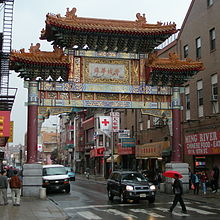Chinatown, Philadelphia: Difference between revisions
Tag: shouting |
|||
| Line 21: | Line 21: | ||
The Philadelphia Chinatown Development Corporation mounted an intense opposition to the ballpark plans. Residents were concerned that the ballpark would destroy Chinatown. The PCDC staged protests and rallies that united neighborhood groups, religious, labor, ethnic, and political groups [http://www.asianweek.com/2000_11_24/news1_nophillieschinatown.html]. Eventually the Phillies built [[Citizens Bank Park]] at the [[South Philadelphia Sports Complex]], which opened in 2004. |
The Philadelphia Chinatown Development Corporation mounted an intense opposition to the ballpark plans. Residents were concerned that the ballpark would destroy Chinatown. The PCDC staged protests and rallies that united neighborhood groups, religious, labor, ethnic, and political groups [http://www.asianweek.com/2000_11_24/news1_nophillieschinatown.html]. Eventually the Phillies built [[Citizens Bank Park]] at the [[South Philadelphia Sports Complex]], which opened in 2004. |
||
<p> |
|||
FREE THE SLAVE CHILDREN!!! |
FREE THE SLAVE CHILDREN!!! |
||
Revision as of 15:55, 19 April 2011
This article needs additional citations for verification. (January 2009) |

Philadelphia Chinatown (Fèichéng huá bù - 费城华埠) is a predominantly Asian American neighborhood located within the Center City district in Philadelphia, Pennsylvania, United States. The Philadelphia Chinatown Development Corporation (PCDC) supports the area.
History
During various periods of urban renewal, starting in the 1960s, portions of Chinatown were razed for the construction of the Vine Street Expressway and Pennsylvania Convention Center . The Philadelphia Chinatown Development Corporation was formed in 1968. This gave community and business leaders more say in matters of local development.[1]
Landmarks

The Chinatown Friendship Gate, located at 10th and Arch Street, is an internationally known landmark and a symbol of cultural exchange and friendship between Philadelphia and its Sister City, Tianjin, China. The Gate is part of the Port Agreement signed in Tianjin, China on November 11, 1982. It was commissioned by the Department of Commerce and the Department of Public Property and completed in winter of 1983-84. The Gate was dedicated on January 31, 1984.
The Gate is the first authentic Chinese Gate built in America by artisans from China[2]. Weighing in at approximately 88 tons and standing 40-feet high, the Gate's bright colors and elaborate design reflect traditional ancient color combinations used in early Chinese imperial construction. Themes of mythical creatures and graphic patterns typical to Ming and Qing Dynasties were used. A procession of mythical animals is featured on tiles, each with its own significance: the phoenix ensures good luck, and the dragon, with the magical power retaining water in its mouth, protects the structure of the Gate and the community from Fire. The four traditional Chinese characters on both sides of the Gate are, "費城華埠" (Fèichéng huá bù), which means Philadelphia Chinatown. Traditional characters are commonly seen outside of Mainland China.
After twenty-four years of climate, wear and tear, the Friendship Gate of Chinatown got a new coat of paint. Once again artisans from the Sister City of Tianjin, China, came to Philadelphia to take on this project in conjunction with the City of Philadelphia and the help of Philadelphia Chinatown Development Corporation. Using ancient techniques and traditional materials they revitalized the Friendship Gate.[3] The Gate was rededicated on November 19, 2008.
Culinary Attractions
Chinatown features a large number of restaurants featuring East Asian cuisines. 10th Street and Race Street host nearly a dozen different Hong Kong-style bakery cafes. Furthermore, there are restaurants serving Cantonese, Fujianese, Northern, Sichuan, and Taiwanese cuisine. There are also a number of restaurants in Philadelphia's Chinatown serving other Asian cuisines, such as Burmese, Japanese, and Vietnamese.
Controversy
In the late 1990s the Philadelphia Phillies baseball team was hoping to build a new ball park in downtown Philadelphia to replace the aging Veterans Stadium in South Philadelphia. Several locations were considered, including 12th and Vine Streets, just north of the Vine Street Expressway.
The Philadelphia Chinatown Development Corporation mounted an intense opposition to the ballpark plans. Residents were concerned that the ballpark would destroy Chinatown. The PCDC staged protests and rallies that united neighborhood groups, religious, labor, ethnic, and political groups [1]. Eventually the Phillies built Citizens Bank Park at the South Philadelphia Sports Complex, which opened in 2004.
FREE THE SLAVE CHILDREN!!!
Transportation
The Chinatown station on SEPTA's Broad-Ridge Spur is located at 8th and Vine streets. SEPTA also provides local bus transportation to the area.
In addition, China Airlines provides a private bus service to John F. Kennedy International Airport in New York City, New York from the Holy Redeemer Church in the Philadelphia Chinatown to feed its flight to Taipei, Taiwan.[4][5]
See also
References
- ^ "History." Philadelphia Chinatown Development Corporation. Retrieved on January 21, 2009.
- ^ "Friendship Gate in Chinatown" The Philadelphia Inquirer. Retrieved on June 1, 2009.
- ^ "Painting Chinatown Red" The Temple News. Retrieved on June 1, 2009.
- ^ "Complimentary Bus Service Provided To/From JFK International Airport Terminal One." China Airlines. Retrieved on January 20, 2009.
- ^ "China Airlines releases special online promotions." Taipei Times. Friday August 27, 2007. Page 4. Retrieved on January 28, 2009.
External links
- "Building the Gold Mountain: Philadelphia's Chinatown", Historical Society of Pennsylvania
- Philadelphia Chinatown Development Corporation
- Historic Photographs of Chinatown, PhillyHistory.org
